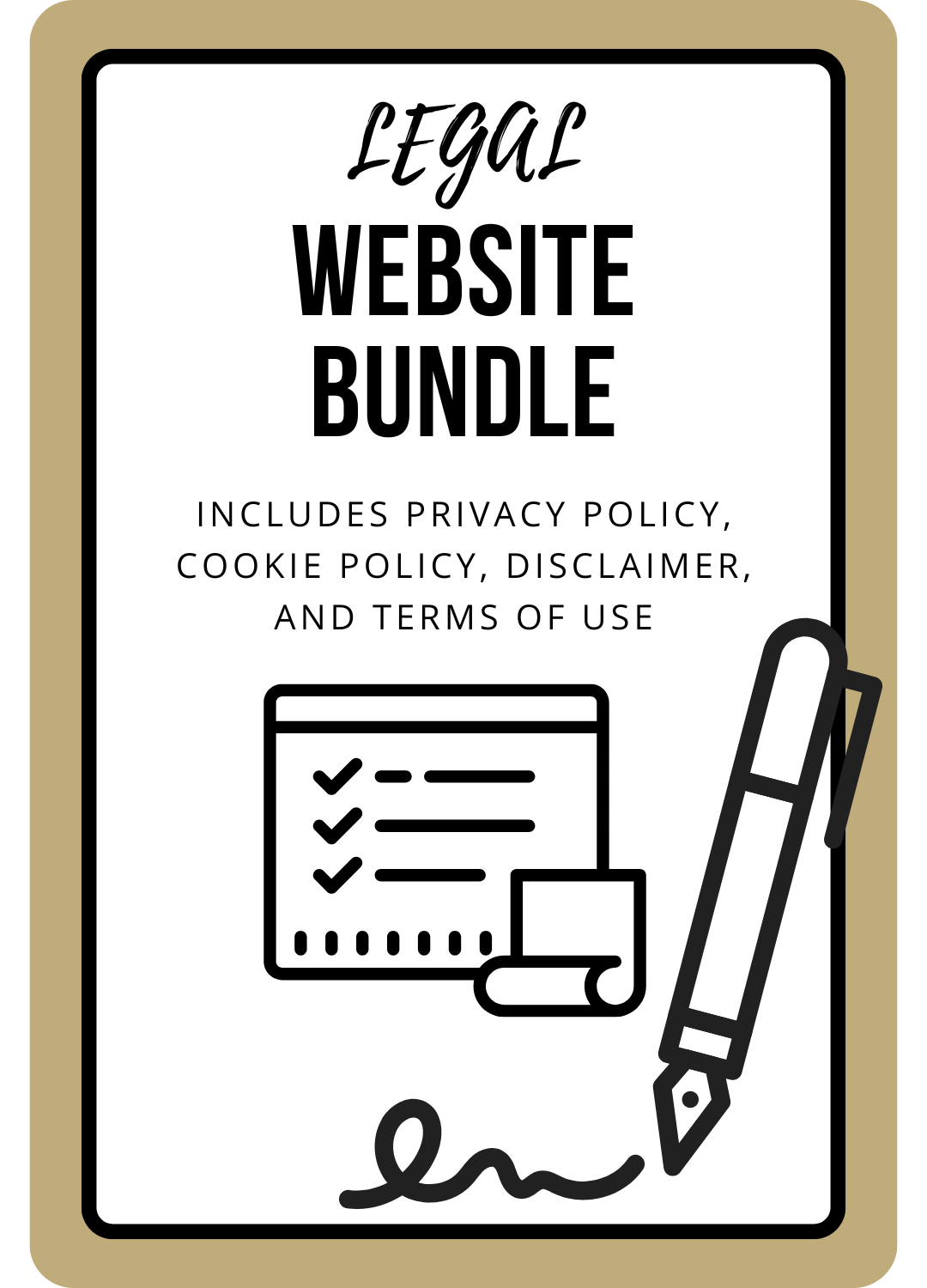Do I Need Terms and Conditions on My Website? 9 Key Things Every Website Owner Must Know
Do I need terms and conditions on my website? It’s one of the most common questions website owners ask — and the short answer is yes, almost always.
Even though they’re not legally required, you need website terms and conditions to set the rules for how visitors can use your site, protect your content from misuse, and limit your liability if something goes wrong.
As a lawyer, I’ve seen the major issues even a simple website can face without a proper website terms and conditions template: copycats, user disputes, misinterpreted content, chargebacks, data issues, or conflicts over what users can and can't do.
In this guide, you’ll learn 9 key things every website owner must know about website terms and conditions — including when you legally need them, what they should include, where to put them on your site, and whether you can use a website terms and conditions generator.
By the end, you’ll understand exactly how to protect your site, your content, and your business in a simple, clear, and legally sound way.
This blog post is all about the 9 key answers to the question, “Do I need terms and conditions on my website?”
👉 Want the shortcut? Get my Legal Website Bundle, which includes a lawyer-drafted Website Terms & Conditions Template, Privacy Policy, and Disclaimer Page — everything your website needs to stay compliant and protected.
Do I Need Terms and Conditions on My Website?
Does Every Website Need Terms and Conditions? 9 Key Things You Must Know
1. Do I Really Need Terms and Conditions on My Website?
If you’re asking, “Do I need terms and conditions on my website?”, the answer is almost always yes — even though most countries don’t legally require them.
Terms and conditions act as the contract between you and your website visitors. They set the rules for how people can use your site, what’s allowed, what’s off-limits, and what happens if someone misuses your content, causes issues, or tries to hold you liable for something that isn’t your fault.
Without them, you have no written agreement to stand on if a visitor behaves badly, posts harmful content, copies your work, or blames you for something outside your control.
⭐ Example: A blogger shared a “Beginner’s Strength Routine.” A reader injured their wrist and demanded compensation, claiming the blogger “should have warned them.”
Without terms and conditions limiting liability and defining acceptable website use, the blogger had nothing to fall back on.
✅ What a proper website terms & conditions template should include
Strong, fluff-free website terms and conditions should clearly state:
Who owns the website and to whom the terms apply
Rules for using the site, including what’s allowed and prohibited
Content ownership, clarifying that all text, photos, videos, and materials belong to you
How visitors may (or may not) share your content
Consequences of misuse, like spam, hacking, data scraping, or illegal behavior
Liability limitations, making it clear users access your site at their own risk
Indemnification, requiring users to cover your costs if they cause harm
Termination rights, so you can revoke access if someone violates your rules
Governing law & jurisdiction, so disputes happen on your turf, not theirs
Third-party link disclaimers, clarifying you’re not responsible for external sites
Update/amendment rights, so you can change your terms anytime
💡 My Website Terms & Conditions Template inside my Legal Website Bundle includes all of these protections — written in plain English, tailored for creators, coaches, and online business owners, and designed to keep your website fully protected from day one.
2. What Happens If I Don’t Have Terms and Conditions?
Skipping terms and conditions might feel harmless — especially if your website is “just a blog” or you don’t sell anything yet. But without them, you have no written rules, no liability protection, and no clear boundaries for how visitors can use (or misuse) your site.
This is where website owners get into trouble.
Without proper T&Cs, you can be blamed, challenged, or taken advantage of in ways you didn’t expect — and have nothing to point to when a dispute arises.
⭐ Example: A finance creator shared “10 Ways to Make Money From Home.” A reader used one of the strategies incorrectly, lost money, and claimed the creator “misled them.” Because the website had no terms limiting liability or requiring users to take responsibility for their own actions, the creator had zero written protection to rely on.
Another common issue? Someone copies your content, republishes it with “credit,” and then argues they “thought it was allowed” — because your website never said otherwise.
❌ Here’s what you risk when you don’t have a proper website terms & conditions template
Without a proper website terms and conditions page:
Users can misuse your content and claim they “didn’t know the rules.”
Visitors may hold you responsible for how they interpret or apply your information.
You have no way to enforce behavior, remove harmful users, or manage disputes.
You may face liability for third-party tools, plugins, or broken external links.
Copycats can push boundaries, making it harder to enforce your rights.
You could be dragged into disputes in another country with no jurisdiction clause to protect you.
You appear less trustworthy to platforms, payment processors, and potential clients.
In short: No terms = no protection.
💡 My Website Terms & Conditions Template inside my Legal Website Bundle includes all the liability protections, user rules, IP rights, and jurisdiction clauses you need — so you’re never left unprotected again.
3. Why Your Website Needs Terms to Protect Your Content & Intellectual Property
You might say, “Why do I need terms and conditions on my website if I’m automatically protected by copyright laws anyway?”
Copyright automatically protects your original content the moment you publish it — but enforcing those rights becomes much easier when your website terms and conditions clearly spell out what visitors can and cannot do with your work.
Many visitors genuinely don’t understand copyright law. Others assume that if your content is online, they’re free to copy, repost, or “borrow” it — as long as they credit you. Without written terms, you’ll deal with more misunderstandings, more copying, and more excuses from people who overstep boundaries.
Your terms make your ownership explicit, and they give you the legal foundation to act quickly when someone infringes.
⭐ Example: A designer noticed another small business using her product photos in their marketing with the caption, “Image via @herwebsite.” When confronted, the business claimed they thought it was “allowed” because no rules were posted on her site.
But once she added clear website terms stating that all content is her intellectual property and cannot be copied without written permission, she had the documentation she needed to issue a takedown notice — and the images were removed immediately.
✅ What a proper website terms & conditions template should include to protect your content
Your website terms of use should:
State that you own all content on your site — including text, images, videos, PDFs, and downloads
Prohibit copying, reproducing, or redistributing your work without written permission
Cover user-generated content, such as testimonials or comments, and how you’re allowed to use them
Include a shareables clause, clarifying what content may be shared and how it must be credited
Explain penalties or consequences for copyright infringement
Ensure your brand assets and trademarks are protected from unauthorized use
💡 My Website Terms & Conditions Template inside my Legal Website Bundle includes all the IP protections you need — so your content, photos, videos, and downloadable materials stay fully protected and clearly marked as yours.
4. How Terms and Conditions Limit Your Liability (Your Legal Safety Net)
To answer your question, “Do I need terms and conditions on my website?”, one of the biggest reasons you do need terms and conditions on your website is liability protection.
Even simple, harmless content can be misinterpreted — and if something goes wrong, people often look for someone to blame.
A proper terms and conditions page makes it clear that visitors use your website at their own risk, your content is not professional advice, and you are not responsible for outcomes, decisions, data loss, damages, or technical issues that occur when users interact with your website.
Without these protections, a single misunderstanding can turn into a costly dispute.
⭐ Example: A wellness coach posted “My 3 Favorite Morning Habits for More Energy.” A reader tried one of the tips, felt unwell afterward, and blamed the coach’s “unsafe advice.”
Because the website had no liability disclaimer and no limitation of liability clause, the coach had no written protection to rely on — and spent weeks dealing with angry emails and refund disputes she wasn’t even legally obligated to provide.
✅ What a proper website terms & conditions template should include to limit liability
Your website terms of use should clearly explain that:
Your content is for information/education only, not professional, medical, legal, or financial advice
Users are responsible for their own actions and how they apply your information
You are not liable for losses, damages, injuries, or outcomes from using your content
You can’t guarantee accuracy or uninterrupted access, especially with tech issues, updates, or third-party tools
Users must indemnify you (cover your costs) if they misuse your website or violate your terms
Your Disclaimer Page applies, especially if you run a niche site (health, fitness, business, finance, DIY, mental health, etc.)
💡 My Website Terms & Conditions Template inside my Legal Website Bundle already includes the limitation of liability, “use at your own risk,” and indemnification clauses your website needs — and it pairs perfectly with my Disclaimer Page Template for full protection.
5. When You Definitely Need Terms and Conditions (Even If Your Website Is “Small”)
Some website owners think they only need terms and conditions once they’re “big enough.”
But certain situations make T&Cs non-negotiable — even for beginners, bloggers, or brand-new creators.
If your website does any of the following, you need terms and conditions right away.
⭐ Example: A creator launched a simple landing page to deliver a free digital download. She didn’t think she needed legal pages because she wasn’t selling anything. Within 3 months:
Someone copied her lead magnet and offered it on their own site
A subscriber complained that her email sequence was “misleading advice”
A tech issue caused her download link to break, and people blamed her
All because she had no terms, no disclaimers, and no usage rules posted anywhere.
✅ You definitely need website terms and conditions if your website:
Collects personal data (emails, names, messages, contact forms, or even just analytics cookies)
Shares any kind of informational or educational content (blog posts, tutorials, tips)
Offers digital downloads or lead magnets, even if free
Uses third-party tools like Stripe, PayPal, Kajabi, Teachable, Meta, Google Analytics, or embedded apps
Accepts payments for courses, coaching, services, or digital products
Allows user-generated content, such as testimonials, comments, or uploads
Includes affiliate links or external recommendations
Involves any professional niche that could trigger liability (fitness, business, health, finance, parenting, etc.)
Lets users create accounts or access protected content
Automatically gathers IP addresses or browsing data, which most platforms do
If any of these apply, your site needs both:
Terms and Conditions (rules + liability + IP protection)
A Privacy Policy (legally required when you collect personal data)
6. Terms vs. Privacy Policy (Do I need a privacy policy on my website, too?)
A lot of website owners confuse terms and conditions with a privacy policy — but they serve two completely different purposes. And yes, in most cases, you need both.
Your website terms and conditions protect you.
Your privacy policy protects your users — and is required by law if your website collects personal data.
So, to answer the question “Do I need a privacy policy on my website?” Yes — since almost every website collects at least some data (name, email, IP address, cookies, analytics), most website owners legally need a Privacy Policy even before they start selling anything.
✅ What your webiste terms and conditions cover (in simple terms)
Fluff-free website terms and conditions explain:
The rules for using your website
What users can and can’t do with your content
Intellectual property rights
What happens if users misuse your site
Liability limitations (“use at your own risk”)
Rules for user accounts, purchases, or downloads
Governing law and jurisdiction
They’re optional legally — but essential for protecting your business.
✅ What your privacy policy must include to comply with the law
An ironclad privacy policy explains:
What personal data you collect (emails, IPs, cookies, analytics, account info)
How and why you collect it
How it’s used (email marketing, analytics, payments, etc.)
If data is shared with third parties (email providers, payment processors)
How users can request deletion or access
Your contact details for privacy-related questions
⭐ In short: Should your website have both? Yes.
Terms & Conditions → protect your business
Privacy Policy → protects your users (and is legally required)
Both documents work together to make your website safe, compliant, and professional.
💡 My Legal Website Bundle includes a lawyer-drafted Privacy Policy and Website Terms & Conditions Template, plus a Disclaimer Page — the three essential pages every website needs to stay compliant and protected.
7. How Terms Help You Manage User Accounts & User-Generated Content
If your website allows users to create an account, log into a member area, upload content, or submit testimonials or comments, then you absolutely need terms and conditions.
Without clear terms, users can:
Share logins
Post harmful or illegal content
Upload materials they don’t own
Dispute account suspension
Demand you remove testimonials they previously approved
Blame you for hacked or misused accounts
Your terms and conditions give you full control over user behavior, what users submit, and what you’re allowed to do with that content.
✅ What strong website terms and conditions should include for user accounts:
Your website terms and conditions should clearly state that:
Users must provide accurate information when creating an account
Users are responsible for keeping their login details secure
You can suspend or terminate accounts at your discretion
Users are responsible for all activity under their account, even if someone else used it
You’re not liable for hacked accounts, password misuse, or user errors
✅ What your terms should include for user-generated content (UGC):
Your website terms of use should explain that:
Users may only submit content they personally own
Users grant you a royalty-free, worldwide license to use submitted content
You may feature testimonials, comments, photos, or submissions on your website or marketing
You can edit or remove submissions at any time
You’re not required to compensate users for content they voluntarily provide
💡 My Website Terms & Conditions Template inside my Legal Website Bundle already includes optional account terms and a built-in user-generated content license — so you can legally use testimonials and submissions without issues later.
8. Why You Need Governing Law & Jurisdiction Clauses (So You Stay in Home-Court Territory)
If a legal dispute ever comes up — over a refund, a copyright claim, a testimonial, or a user’s complaint — your website terms and conditions determine where and under which laws that dispute must be resolved.
Without these clauses, anyone from anywhere could try to drag you into their country’s legal system,
A governing law and jurisdiction clause prevents that.
⭐ Example: A U.S.-based designer sold a digital product. A customer in Germany demanded a refund and threatened to sue her in German court.
Because her terms stated that all disputes were governed by Florida law and handled exclusively in Florida courts, she didn’t have to defend herself overseas.
That one clause saved her thousands in legal fees and months of stress.
✅ What a proper website terms and conditions template should include about disputes:
Your T&Cs should make it clear that:
Your country or U.S. state’s laws apply — not the visitor’s
All disputes must be brought in your chosen courts or arbitration venue
International users automatically agree to your local jurisdiction
You can recover legal fees if someone brings an unreasonable or unsuccessful claim
💡 My Website Terms & Conditions Template inside my Legal Website Bundle already includes these governing law, jurisdiction, and dispute-resolution clauses — written in plain English so you stay fully in control if any disagreement ever arises.
9. Many Platforms, Payment Providers, & Apps Require Them
Even if you never get sued, there’s another reason you can’t skip website terms and conditions:
👉 Most platforms now require them before they’ll let you use their tools.
Payment processors, website builders, ad networks, and affiliate programs increasingly check whether your website has website terms and conditions and a privacy policy.
If you don’t, your account can be delayed, rejected, or even suspended.
This applies whether you’re selling a $12 digital download, running a coaching program, or simply collecting emails.
⭐ Example: A business owner tried setting up Stripe to sell a PDF guide.
Stripe flagged her account and froze payouts because she didn’t have website terms & conditions or a privacy policy on her site. Once she added them, her account was instantly approved.
❗ If you don’t have proper legal pages:
Your account can be rejected or suspended
You may be unable to accept payments
Ad accounts can be denied or shut down
Affiliate applications may be blocked
You’ll have little protection if a user files a complaint
So yes — in practice, almost every website needs terms and conditions just to operate normally online.
Do I Need a Privacy Policy on My Website? (Yes — If You Collect Any Personal Data)
If your website collects any personal information at all, then yes — you legally need a Privacy Policy.
And this applies even if you think your website is “small,” “just a blog,” or “not really collecting anything.”
Most modern websites collect data automatically through things like:
Contact forms
Newsletter signups
Cookies
Analytics tools (like Google Analytics)
Payment processors
Embedded video players or third-party apps
That means you’re collecting personal data, and once you do, you become legally obligated to disclose it.
Why a Privacy Policy Is Legally Required
Across many countries — including the U.S., EU, UK, and Canada — data protection laws require you to clearly explain:
What information you collect
Why you collect it
How it’s stored and protected
With whom it’s shared
How users can access or delete their data
This is mandatory under laws like:
GDPR (EU/UK)
CCPA/CPRA (California)
PIPEDA (Canada)
And other global data privacy laws
Even if you only collect names and email addresses, you still need a Privacy Policy.
What a legally compliant Privacy Policy must include
A proper Privacy Policy should clearly state:
What personal data you collect (names, emails, IP addresses, analytics data, etc.)
How data is collected (forms, cookies, checkout pages, analytics)
How you use the data (marketing, customer service, product delivery)
Whether you share data (payment processors, email service providers, analytics tools)
How users can request access, correction, or deletion
Your contact details (so users can reach you with privacy concerns)
Don’t skip age requirements — they matter more than you think
Google checks for this. Platforms check for this. Privacy regulators check for this.
Your Privacy Policy should state:
Your site is intended for adults, and you do not knowingly collect data from anyone under 18
You do not permit children under 13 to submit personal data
Users ages 13–17 may only provide data with parental or guardian consent
These requirements protect you legally — especially if you use ads, analytics, or email marketing.
The ULTIMATE Website Terms and Conditions Template + 2 Other Essential Legal Pages for Your Website
So, in answer to your question, “Do I need terms and conditions on my website?”: Yes—without a proper website terms and conditions template, you’re exposed to unnecessary risks every time someone visits, reads, or buys from you.
Instead of scrambling later when a platform flags your site, a visitor misuses your content, or a payment provider asks for your legal pages, you can set everything up now… in less than an hour.
With my Legal Website Bundle, you get:
✅ Website Terms & Conditions Template — covers rules, liability, IP, user conduct & more
✅ Privacy Policy Template — legally required if you collect any personal data
❗ Niche-Specific Disclaimer Page Template — protects you from misuse of your content
All three are lawyer-drafted (by me!) in plain English — no jargon, no fluff, just real protection tailored for creators, coaches, service pros, and online entrepreneurs.
👉 Get the Legal Website Bundle now and publish the three essential legal pages every website needs.
This post was all about the 9 key reasons to the question, “Do I need terms and conditions on my website?” — to stay compliant, protected, and ready for any platform.
Other posts you may like:








